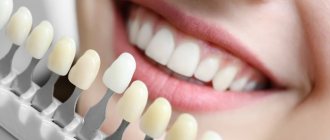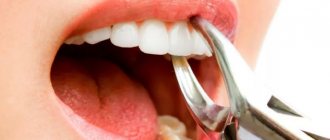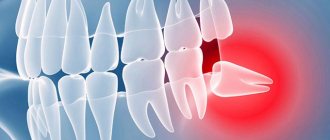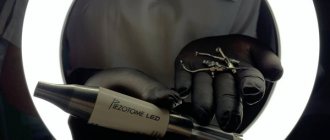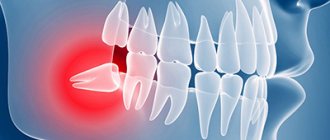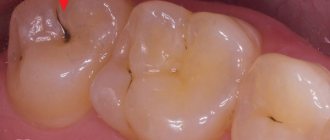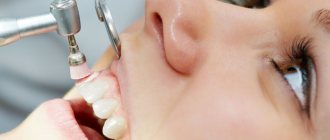In times of minimally invasive treatment methods, the use of piezoelectric equipment is becoming increasingly common among dentists and oral surgeons who perform surgical procedures. Lasers in dentistry are used to perform surgical procedures with minimal discomfort for the patient. However, piezoelectric equipment allows hard tissue to be treated delicately through the use of ultrasonic surgery. So, how to remove tartar using ultrasound and what are the advantages of this method.
Ultrasound tooth extraction technology
Ultrasound tooth extraction refers to piezosurgery, which allows manipulation using ultrasonic waves. In dentistry, technology is actively used in implantation and bone grafting, maxillofacial surgery and, of course, tooth extraction. This is a modern, safe and painless alternative to classic forceps, elevators and drills.
The piezosurgical device is an expensive and multifunctional device. It consists of a workstation, a water container and tips, which in professional environments are often called ultrasonic pointers. Due to their design, these pointers can be used even in the most difficult to reach areas of the jaw.
Advantages of piezosurgery
- High precision and minimal invasiveness.
Ultrasonic waves do not require direct contact with the surface and provide very high precision in the surgical area, which allows you to preserve the maximum volume of healthy tissue and significantly reduce bleeding and the invasiveness of the entire procedure. - Without pain and discomfort.
Unlike a drill, an ultrasonic scalpel does not heat the tooth tissue, so the operation is as comfortable as possible for the patient and often does not require the use of anesthesia. - The procedure goes quickly.
Treatment time is reduced by 15-20%. - Without consequences.
Minimal risk of complications.
Delete cannot be left
“The smart ones remove wisdom teeth,” many Russian dentists say. They are sure that it is best to get rid of eights during the period of change in bite, when the jaw bones have not yet “increased” sufficient density.
But so far this opinion is not shared by everyone, and opponents present well-founded arguments. The main one is the possibility of using the “sage” as a support for a bridge.
Most often, wisdom teeth are removed if they are incorrectly positioned and have difficulty erupting. For various reasons, they grow inside the jaw bone and may never overcome the gum barrier. The operation to extract such teeth is quite difficult, and it is recommended to do it in maxillofacial surgery.
Wisdom teeth are no different in appearance from other molars. They have the same crown and developed roots, but functionally they are far behind the sixes and sevens. Eights practically do not participate in the chewing process and serve only as a kind of fence that protects the dentition from divergence and loosening.
In 8 out of 10 patients, wisdom teeth cause problems with eruption.
Indications and contraindications
Ultrasonic tooth extraction can be used in all cases where extraction is necessary. The location and type of tooth does not matter. At the same time, there are a number of indications when a doctor can strongly recommend the use of ultrasound to ensure a predictable result and minimize possible complications:
- the patient has a bleeding disorder;
- abnormal position of teeth;
- complex tooth extraction that is covered with soft tissue growths;
- after an unsuccessful classical removal procedure;
- wisdom tooth removal;
- removal of impacted and dystopic teeth (in particular, eights with pathology);
- tooth extraction and immediate implantation;
- tooth extraction during pregnancy;
- tooth extraction for children, especially those with severe dental phobia.
The procedure also has a number of contraindications, in the presence of which the use of ultrasound is not recommended or strictly prohibited:
- For patients with a pacemaker, ultrasound is completely contraindicated;
- milk and mixed dentition in children (not recommended);
- HIV, hepatitis, tuberculosis;
- bronchial asthma;
- disorders of the central nervous system, mental disorders;
- extensive demineralization of enamel.
What is piezosurgery? Features, nuances, indications
Piezosurgery (non-contact surgery) is an innovative method of performing surgical operations based on the influence of ultrasound. The procedure is performed using a piezotome - an ultrasonic knife that produces vibrations, thereby carefully and as accurately as possible affecting the tissues of the oral cavity. This is a more “advanced” alternative to well-known surgical techniques in dentistry, the ability to abandon traditional burs and bone drills. During the procedure, the effect is not mechanical, but ultrasonic.
This is interesting! The piezosurgical dental instrument was invented in 1988. The action of the knife is based on oscillations of ultrasound waves (from 60 to 200 mm/sec), which ensure safe and precisely targeted cutting of gums and hard tissues. Soft tissues, as well as blood vessels and nerves are not injured.
Main indications for piezosurgery:
- removal of patients' teeth, including wisdom teeth;
- building up bone tissue before implantation (in particular, taking material to prepare the area for surgery);
- removal of cystic formations, granulomas;
- sinus lift or elevation of the maxillary sinuses;
- microsurgical operations on the jaw, for example, opening of the mandibular alveolar nerve, removal of tumors, etc.
Despite the fact that the operation has a minimal number of contraindications, piezosurgery is still not recommended for some patients. For example, people with diabetes, oncology, serious disorders of the nervous system, problems with blood clotting, and also if they have a pacemaker.
Also, one of the contraindications for the procedure is the presence of fillings in the tooth. When using ultrasound, there is a high risk of damage to the filling material, so when working with such a knife, high qualifications are required.
Dentistry for those who love to smile
+7
Make an appointment
Ultrasound removal of wisdom teeth
Removing a wisdom tooth using ultrasound is one of the most common manipulations in piezosurgery. There are several reasons for this. Firstly, the figure eights are initially located deep in the jaw, so it is sometimes very difficult to remove them using ordinary forceps. The situation is also complicated by various pathologies, which are very common in the case of wisdom teeth. First of all, this is retention and dystopia. In the most difficult cases, the wisdom tooth is not only hidden under a layer of bone and soft tissue and has an abnormal position. That is why removal of an impacted tooth using ultrasound is one of the most popular piezosurgical procedures. An ultrasonic device allows you to perform manipulations with pinpoint precision and work with bone in the most gentle manner. Removing wisdom teeth in the lower jaw using ultrasound can take a little longer and be more difficult (largely due to denser bone). Read more about wisdom tooth removal here.
Recommendations
After the procedure, the dentist gives recommendations. Immediately after removal, the patient is given cold to the cheek: this will prevent swelling. When the effect of anesthesia wears off, the patient may experience pain for some time - this is normal. In this case, you can take the painkiller that the doctor suggested.
For 3-5 days, it is recommended to eat food at a neutral temperature, without heat or spices. Usually on the third day the patient is invited for a follow-up examination.
Saliva makes wounds in the mouth heal much faster. Only the first day will be the least accepted. If you follow the dentist's recommendations, the postoperative period will pass quickly and calmly.
- Recommendations after surgery .pdf
- Postoperative recommendations .pdf
How is the procedure done?
Ultrasonic tooth extraction is not much different from the classical technique. The key difference is that in the first case, most manipulations are carried out using an ultrasonic pointer, while in the second case, most of the manipulations are carried out using conventional dental instruments. The entire procedure can be divided into several key stages.
- Initial consultation, at which indications and contraindications for the procedure are determined.
- Taking tests (if necessary).
- Anesthesia. Local anesthesia is usually used.
- Surgical stage. Ultrasound affects hard tissue and literally peels the gum away from the body of the tooth. Thus, ultrasonic tooth root removal occurs with minimal invasiveness and blood loss. The specialist applies a special antiseptic solution to the surgical area, which, together with ultrasound, helps to avoid possible infection.
Disadvantages of classical removal methods
Classic extraction methods have several disadvantages:
- trauma to mucous and bone tissue;
- the likelihood of chipping on neighboring teeth, as well as fragments that will be difficult to remove;
- the possibility of damage to the bone socket of the tooth and surrounding tissues so that it will be difficult to implant in the future;
- the occurrence of complications in the form of inflammation of regional lymph nodes;
- severe damage to the mucous membrane;
- long regeneration time.
Conventional removal or ultrasound?
So, is ultrasound tooth extraction technology modern and effective? Absolutely yes. Is it worth choosing it if it is not possible to save the tooth? Yes, because piezosurgery has a number of very important advantages compared to the classical extraction technique. At the same time, the cost of ultrasonic tooth extraction is quite high: for one unit you will have to pay at least 4–5 thousand rubles. The classic removal procedure will cost about half as much.
Attention!
The final success of treatment primarily depends on the qualifications and professionalism of the attending physician. That is why choosing a specialist who you can trust with your health is paramount. Startsmile will always help you find a suitable clinic and specialist.
Modern dentistry
Our clinic employs specialists who regularly study in Russia, Germany, Austria, Japan and Italy.
Advantages of ultrasound removal at the Uniklinik Center for Modern Medicine:
- performing a computed tomography scan to assess the anatomical complexity of the tooth;
- choosing the optimal treatment method;
- use of high-precision equipment;
- use of magnifying equipment in work: microscope, binoculars;
- painlessness of the procedure;
- control inspection.
Removing 4 eights in one session
Removing all the sages at once can be a very reasonable and rational decision for certain indications. Most often, one-stage extraction is carried out for orthodontic indications, when it is necessary to install braces or corrective aligners.
The main advantage of such surgical treatment is the uniform and symmetrical movement of dental units due to the voids formed in the jaw in place of the sockets. After about 2 months, the sockets are overgrown with new bone, and the teeth can no longer move as easily and quickly. Thus, the duration of treatment by an orthodontist is reduced.
If removal is carried out for other indications, then this also has its advantages:
- When teeth are crowded, they move apart, thereby aligning the dentition. Otherwise, the doctor may recommend wearing special aligners to contain the process, in order to avoid the formation of large interdental gaps in the row;
- manipulations are performed by two dental surgeons in an average of 1 hour;
- anesthesia or sedation is carried out once, and not several times, if you part with the eights in turn;
- It is enough to take antibiotics only once instead of four times, which is especially important for chronic diseases;
- discomfort, pain and inconvenience when eating also will not have to be experienced twice.
Rehabilitation
During the recovery period, dentists prescribe a course of antibacterial therapy and painkillers for the shortest possible course. That is, you should take analgesics as long as the pain persists. Most often, non-steroidal anti-inflammatory drugs based on ibuprofen and nimesulide (Nise) are prescribed for pain, which effectively relieve both pain and inflammation.
Antihistamines are prescribed to prevent generalized swelling in the area of the tooth socket.
It is highly advisable to quit smoking: nicotine interferes with the normal blood clotting process and can cause bleeding.
To speed up wound healing, it is recommended to rinse your mouth with antiseptics and eat liquid and soft foods for several days.
